- TOP
- INFORMATION
- Rail Travel
Rail Travel
Trains
Types of Trains in Japan
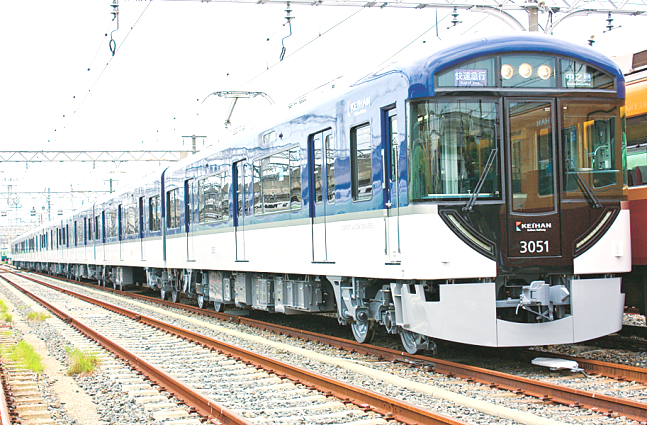
Japan has a highly-developed railway network that covers almost every area of the country. The trains are very punctual, leaving and arriving at fixed times. In areas outside the inner city, there are some train lines that have infrequent service or for which the last train is early. During long national holidays, high passenger volumes can make it difficult to get a reserved seat. Also be aware that trains running through the inner city durring peak times can become so crowded that it becomes impossible to even move your arms.
The Japanese rail system is comprised of lines owned by the Japan Railway Company (including shinkansen lines), lines operated by private railway companies, and the subway systems of Sapporo, Sendai, the greater Tokyo area, Nagoya, Kyoto, Osaka, Kobe, Hiroshima, and Fukuoka.
Other transportation systems include monorail, ropeway, and trolley systems. These differ from private train lines in that transfers and the purchasing of tickets takes more time and effort. It is therefore a good idea to check relevant information when creating an itinerary that involves travel by such means.
Searching for Train Routes and Times
Knowing which train to take before you head to the station is always a good idea. Using either of the websites below, you can search for train routes. You can also filter your search results by departure or arrival time, fastest travel time, cheapest fare, and more.
HyperDia (English page available)
Navitime (Japanese only)
Tickets
Train Types and Fares
JR lines are owned by six companies: JR Hokkaido, JR East, JR Central, JR West, JR Shikoku, and JR Kyushu. Each one services its respective area. Through fares are calculated for all travel passing through a JR area. Some companies may sell their own discounted tickets for travel within their serviced area. Discounts are also offered when transferring to a shinkansen (bullet train) or other JR lines.
Taking shinkansen or limited express trains requires an additional charge called a "limited express fee." There is also a reserved seat fee when reserving a seat. For private railways, almost all short-distance trains can be ridden with just a base fare ticket even if they are "limited express" or "express" trains. A limited express ticket will be needed to ride long-distance limited express trains operated by companies such as Kintetsu, Tobu, and Odakyu. Ask a station attendant if you are unsure if you need an express ticket.
In addition to limited express and express trains, there are also semi-express, special express, commuter express, rapid, or local service trains. These specifications depend on the number of stations a train stops at within its area of operation. Be aware that arrival times and stops differ for each train and that train type definitions are not always the same among different rail companies.
In most cases, fares are combined when train travel spans multiple companies in the Greater Tokyo or Osaka regions. For example, passengers receive a discount on transfers between the various Tokyo subway systems (e.g. Tokyo Metro and the Toei Subway). Additionally, transfer tickets that allow passengers to travel on the trains of multiple companies with a single ticket are also sold for certain routes, and discounts are sometimes available. Passengers may need to adjust fares at ticket gates when transferring. Service spanning the train lines of several companies is extremely rare in small cities.
If you have a Japan Rail Pass (also known as the JR Pass), you can use JR Group lines, the Tokyo monorail from Haneda Airport, and certain lines in Aomori, Ishikawa, and Toyama prefectures free of charge.* You will need to pay the regular fare for subways and private rail lines.
*Please note that the JR Pass cannot be used for the Nozomi and Mizuho shinkansen
Purchasing Tickets and Using Ticket Gates
Tickets for stations indicated on ticket machine signboards (usually those stations located within about 100 km) can be purchased from automatic ticket machines. Confirm the fare price for your destination, press the Fare button, and insert payment. The machine will print a ticket for you. Automatic ticket machines with English language support can be found at stations in large cities. Tickets for long-distance travel must be purchased at ticket counters.
When at a ticket counter, state your destination (e.g. Asakusa's Kaminarimon or Kyoto's Kinkaku-ji Temple) and the time you wish to arrive. In Japan, ticket counter staff will tell you the best route, even if it involves traveling on a different company's line. If you try to buy a ticket by stating a station name for your destination, it may be that that station is not the closest to your destination or that no limited express train stops there.
Almost all ticket gates are automatic at train stations in urban areas. When boarding a train, you will need to pass through a ticket gate. Inserting your ticket into the slot in the gate will open the gate doors. The ticket you put in will come out again at the end of the gate; do not forget to pick it up! After getting off a train, insert your ticket into the ticket gate to exit gate doors. The machine will keep your ticket this time.
If you need to transfer to a different line, go through a transfer ticket gate. The ticket will be ejected from the machine just as when first boarding a train. Do not forget to take them.
Many train stations in rural areas do not have automatic ticket gates. In this case, show your ticket to a station attendant. If there is no station attendant, then look for a ticket box next to the gate and put your ticket inside.
Buying JR Tickets
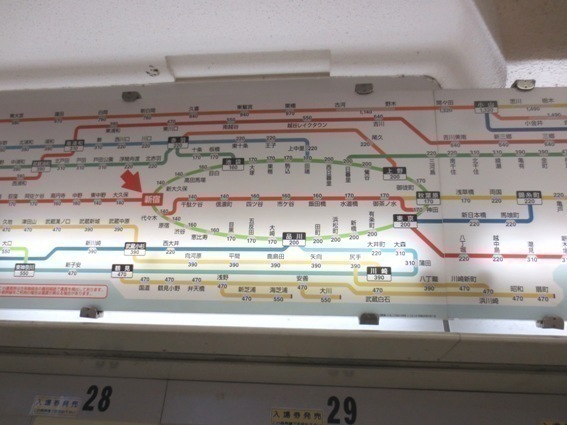 ① Look up the fare for the station you wish to go to using the route map. After confirming the price, press the English button on the screen to change the language to English.
① Look up the fare for the station you wish to go to using the route map. After confirming the price, press the English button on the screen to change the language to English.
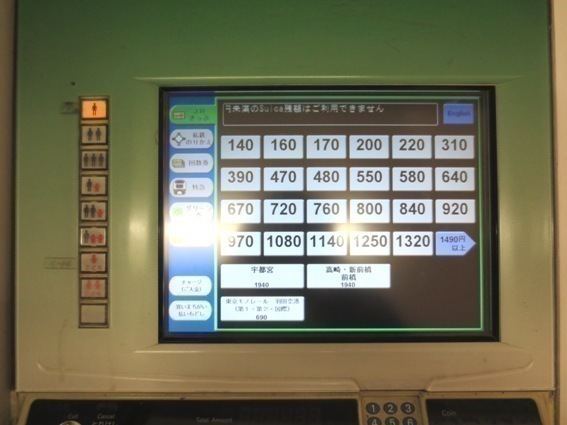 ② Press the button displaying the fare for the station you wish to go to. When using a multifunction ticket machine (i.e. those that sell commuter passes and etc.), press the Ticket button to display the fares.
② Press the button displaying the fare for the station you wish to go to. When using a multifunction ticket machine (i.e. those that sell commuter passes and etc.), press the Ticket button to display the fares.
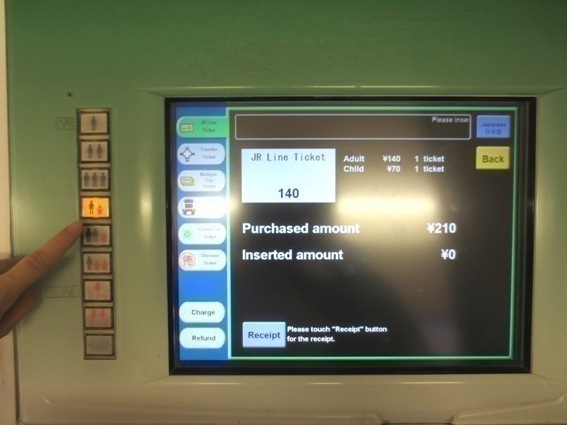 ③ To the left of the screen there are buttons with illustrations of people. Pressing these sets the number of passengers for whom you will purchase tickets. If you do not select a button, the default is one passenger.
③ To the left of the screen there are buttons with illustrations of people. Pressing these sets the number of passengers for whom you will purchase tickets. If you do not select a button, the default is one passenger.
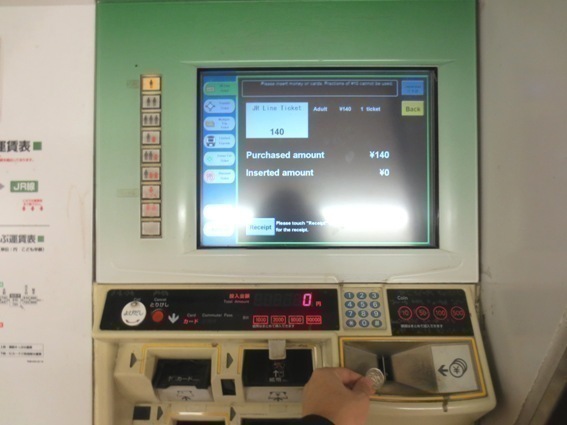 ④ Next, insert payment. The fare and the amount of money you've inserted will be displayed on the screen. Depending on the machine, credit cards, IC cards, cash, and coins are accepted as payment. Note that bills and coins are inserted using separate slots.
④ Next, insert payment. The fare and the amount of money you've inserted will be displayed on the screen. Depending on the machine, credit cards, IC cards, cash, and coins are accepted as payment. Note that bills and coins are inserted using separate slots.
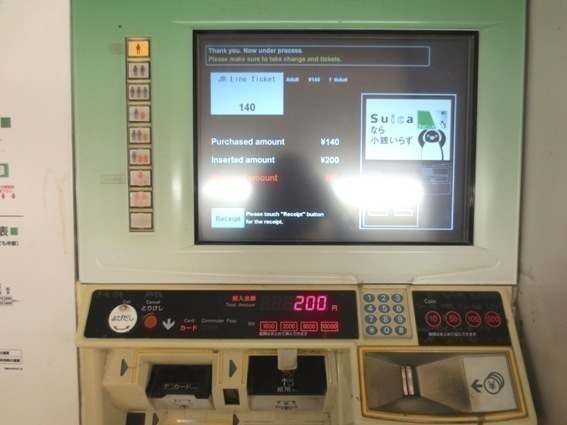 ⑤ The slot for inserting coins will close when you have entered the exact fare amount or more. If you need a receipt for your purchase, press the Receipt button in the bottom right hand corner at this time. The Receipt button is only displayed for a brief time.
⑤ The slot for inserting coins will close when you have entered the exact fare amount or more. If you need a receipt for your purchase, press the Receipt button in the bottom right hand corner at this time. The Receipt button is only displayed for a brief time.
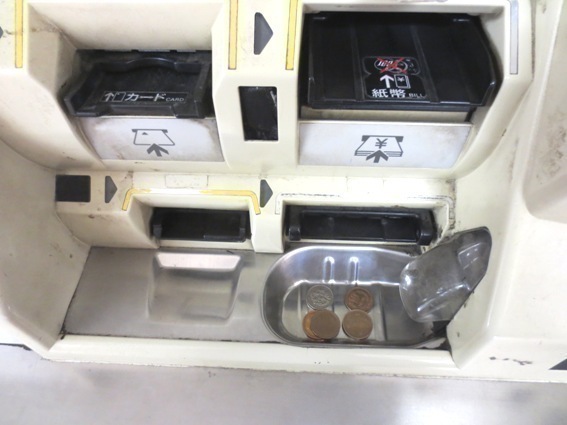 ⑥ Take your ticket and any change that comes out of the machine. Should you need to cancel before completing your purchase, press the Cancel button. You can also press the Call button to call a station attendant should you need assistance.
⑥ Take your ticket and any change that comes out of the machine. Should you need to cancel before completing your purchase, press the Cancel button. You can also press the Call button to call a station attendant should you need assistance.
Purchasing Metro Tickets
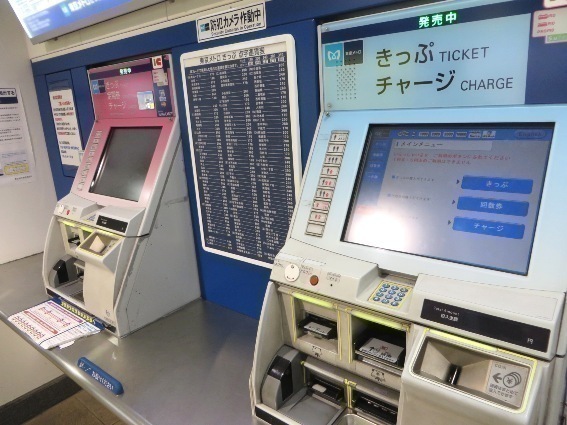 ① Look up the fare for the station you wish to go to using the route map. After confirming the price, press the English button on the screen to change the language to English.
① Look up the fare for the station you wish to go to using the route map. After confirming the price, press the English button on the screen to change the language to English.
 ② When the language changes to English, press the Ticket button. Then press the fare amount for the station you wish to go to. To the left of the screen there are buttons with illustrations of people. Pressing these sets the number of passengers for whom you will purchase tickets. If you do not select a button, the default is one passenger. Insert payment using the slots at the bottom of the ticket machine. Note that bills and coins are inserted using separate slots.
② When the language changes to English, press the Ticket button. Then press the fare amount for the station you wish to go to. To the left of the screen there are buttons with illustrations of people. Pressing these sets the number of passengers for whom you will purchase tickets. If you do not select a button, the default is one passenger. Insert payment using the slots at the bottom of the ticket machine. Note that bills and coins are inserted using separate slots.
With subways, there may be portions of your route where you will transfer to another company's line while in transit. To purchase a ticket that will cover the price of both lines, press the Connecting Line button. Select the name of the line and station to which you are connecting. Pay the fare amount displayed on the screen. Discounts are usually applied when using different companies in one trip (e.g. the Tokyo Metro and the Toei Subway, or the Toei Subway and a private railway).
 ③ The slot for inserting coins will close when you have entered the exact fare amount or more. If you need a receipt for your purchase, press the Receipt button in the bottom right hand corner of the screen at this time. The Receipt button is only displayed for a brief time. Take your ticket and any change that comes out of the machine. Should you need to cancel before completing your purchase, press the Cancel button. You can also press the Call button to call a station attendant should you need assistance.
③ The slot for inserting coins will close when you have entered the exact fare amount or more. If you need a receipt for your purchase, press the Receipt button in the bottom right hand corner of the screen at this time. The Receipt button is only displayed for a brief time. Take your ticket and any change that comes out of the machine. Should you need to cancel before completing your purchase, press the Cancel button. You can also press the Call button to call a station attendant should you need assistance.
IC Card Overview
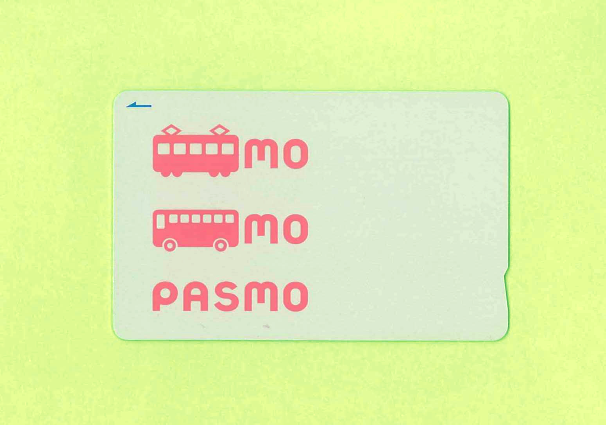
Every company has different rules concerning the extent to which IC cards can be used. In general, IC cards used for public transportation in major cities like JR East's Suica card and the PASMO card that is used on private railways in the Greater Tokyo Area can be used interchangeably. These cards have a wide range of uses throughout Japan and more are added every year.
Purchasing an IC Card
When purchasing an IC card, you have the option of either a named or blank card. A named card requires that you register your card by providing some information about yourself. Choosing this option will allow you to receive a replacement card should you lose it.
Purchasing an IC card requires paying a deposit for the card itself that is refunded when you return the card. Cards can be purchased, reissued, or returned at JR Group Midori no Mado-guchi (Green Window) ticket counters and at stations operated by private railways and subway companies.
Although IC cards generally work with all automatic ticket gates, some stations do not have such gates. In such situations, do not panic: it is often possible to use an IC card machine or have a station attendant scan your card.
IC Card Service Throughout Japan
There are 10 kinds of IC cards in Japan, all of them are interchangeable within each area.
- Kitaca (JR Hokkaido)
- PASMO (Greater Tokyo Area private railways, subways, and buses)
- Suica (JR East)
- Manaca (Nagoya railways, Toyohashi railways, Meitetsu buses, and Nagoya municipal subways and buses)
- TOICA (JR Central)
- PiTaPa (Kansai region and Okayama region private railways and subways, etc.)
- ICOCA (JR West)
- Fukuoka municipal subways and buses)
- Nimoca (Nishitetsu trains and buses, etc.)
- SUGOCA (JR Kyushu)
Using IC Cards
IC cards can be used for more than just train travel; they can be used as electronic money anywhere that has an IC card reader, which may include buses, taxis, coin-operated lockers, vending machines, station kiosks, convenience stores, as well as some cafes and shops inside train stations. IC cards can be recharged at ticket machines or ticket counters.
To pay with electronic money, show your IC card at the register and state that you wish to pay using your card. The clerk will direct you to their card reader. IC cards can be used interchangeably as electronic money among companies that allow interchangeable use of IC cards to pay for base fare. Example: A Suica card purchased in Tokyo can be used as payment in Sapporo.
Recharging an IC Card
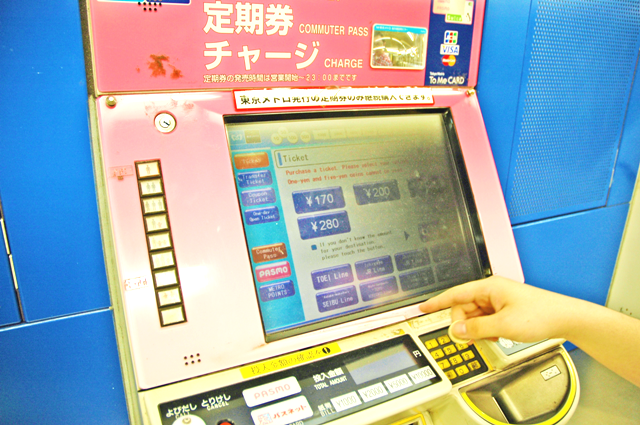 ① In this example, we are using a PASMO card. These steps apply to other types of IC cards as well such as a SUICA card. To purchase or recharge an IC card, press the English button on the ticket machine and then press the PASMO button.
① In this example, we are using a PASMO card. These steps apply to other types of IC cards as well such as a SUICA card. To purchase or recharge an IC card, press the English button on the ticket machine and then press the PASMO button.
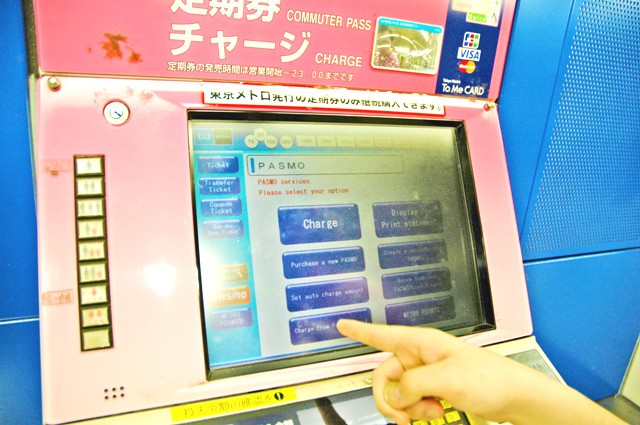 ② A menu will appear. Press either the Purchase New Card or Charge button.
② A menu will appear. Press either the Purchase New Card or Charge button.
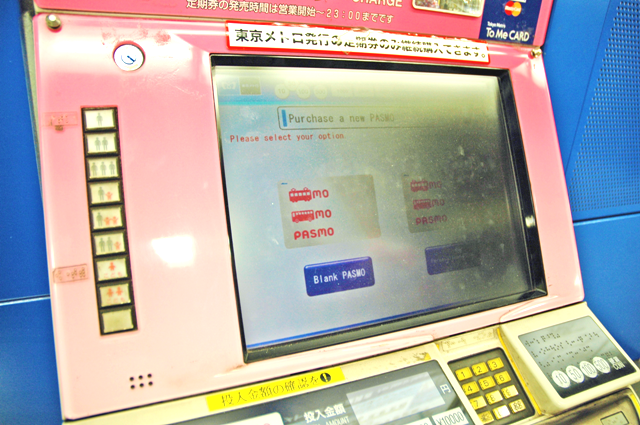 ③ When selecting Purchase New Card, you will be asked to choose either Named or Blank. Choose Named if you wish to be able to reissue a card in the event that it is lost. This option will require you to provide some information about yourself. If you experience difficulties using the machine, purchases can also be made at the service office. Selecting Blank will take you directly to the card charging screen.
③ When selecting Purchase New Card, you will be asked to choose either Named or Blank. Choose Named if you wish to be able to reissue a card in the event that it is lost. This option will require you to provide some information about yourself. If you experience difficulties using the machine, purchases can also be made at the service office. Selecting Blank will take you directly to the card charging screen.
 ④ The charging screen is the same for making your initial charge as it is for all subsequent charges. Simply press the amount you wish to add to the card.
④ The charging screen is the same for making your initial charge as it is for all subsequent charges. Simply press the amount you wish to add to the card.
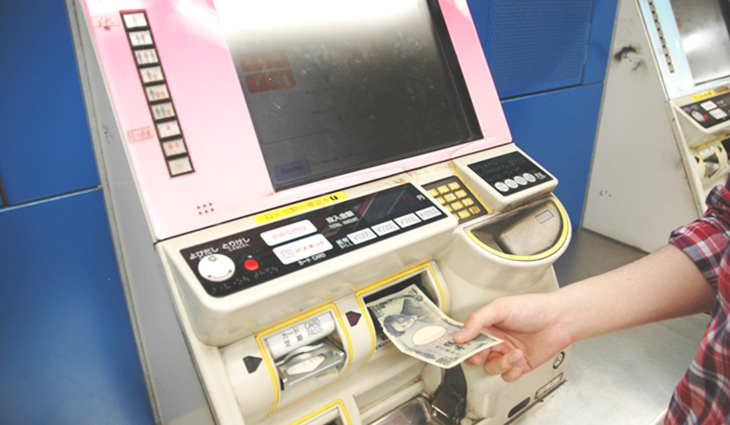 ⑤ Insert cash or coins for the amount you selected.
⑤ Insert cash or coins for the amount you selected.
 ⑥ The amount tendered, the total price, and the amount of change is shown. When purchasing a new card, a ¥500 deposit will be added. The deposit is refunded when you return the card. Cards can be returned at the service office.
⑥ The amount tendered, the total price, and the amount of change is shown. When purchasing a new card, a ¥500 deposit will be added. The deposit is refunded when you return the card. Cards can be returned at the service office.
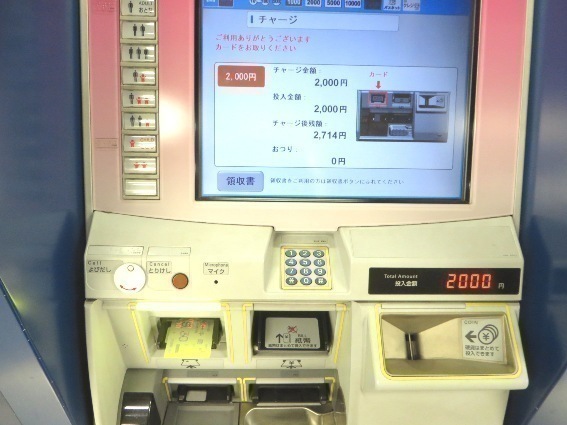 ⑦ Take the IC card after it is issued by the machine. The card may be used immediately.
⑦ Take the IC card after it is issued by the machine. The card may be used immediately.
Boarding and Transferring Trains
1. Entering the Ticket Gate
 ① Follow arrows and signs to find the line you want to use.
① Follow arrows and signs to find the line you want to use.
 ② Pass through a ticket gate displaying the symbols ○ or ↑ (not ×). Put your ticket in the insertion slot. If you are using an IC card, simply touch the card to the IC card sensor. Please note that there are some ticket gates that can only accept IC cards while others only accept tickets.
② Pass through a ticket gate displaying the symbols ○ or ↑ (not ×). Put your ticket in the insertion slot. If you are using an IC card, simply touch the card to the IC card sensor. Please note that there are some ticket gates that can only accept IC cards while others only accept tickets.
Those using a JR Pass should proceed to a staffed ticket gate and display their pass.
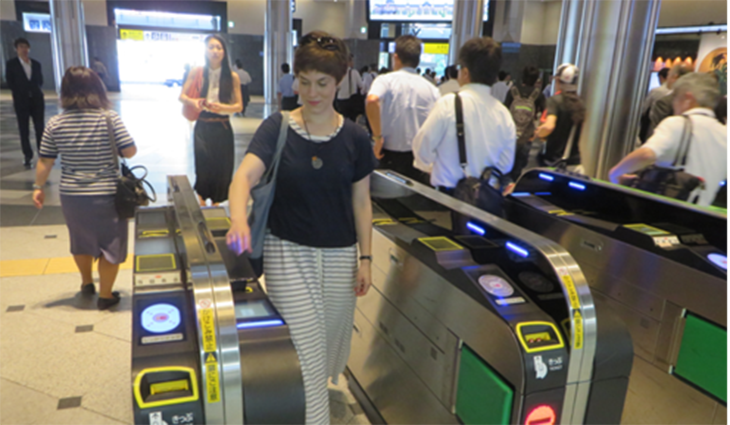 ③ After inserting your ticket or touching your IC card, proceed through the gate. If the IC card balance is insufficient, the tickets are damaged, or the IC card swipe does not register, the gates will close in front of you and there will be a sound and an illuminated sign. If your tickets are not returned by the machine, the gates do not open despite repeated attempts, or you do not know what the problem is, call a station attendant. If there is no attendant at the ticket gate, use the intercom.
③ After inserting your ticket or touching your IC card, proceed through the gate. If the IC card balance is insufficient, the tickets are damaged, or the IC card swipe does not register, the gates will close in front of you and there will be a sound and an illuminated sign. If your tickets are not returned by the machine, the gates do not open despite repeated attempts, or you do not know what the problem is, call a station attendant. If there is no attendant at the ticket gate, use the intercom.
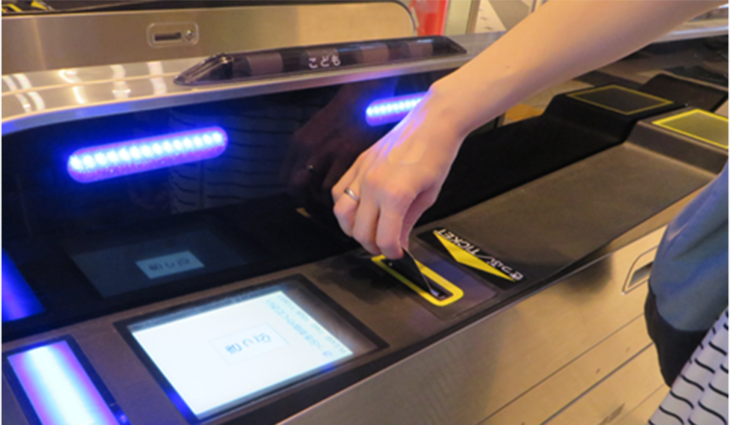 ④ If you are using a ticket, the ticket will be returned to you from the ticket pickup slot at the back of the gate. Do not forget to pickup your ticket! If you do not take it promptly, it will be pulled back into the machine and you will need to call an attendant to retrieve your ticket. If you have used an IC card, simply proceed through the gate.
④ If you are using a ticket, the ticket will be returned to you from the ticket pickup slot at the back of the gate. Do not forget to pickup your ticket! If you do not take it promptly, it will be pulled back into the machine and you will need to call an attendant to retrieve your ticket. If you have used an IC card, simply proceed through the gate.
2. Getting On and Off a Train Car
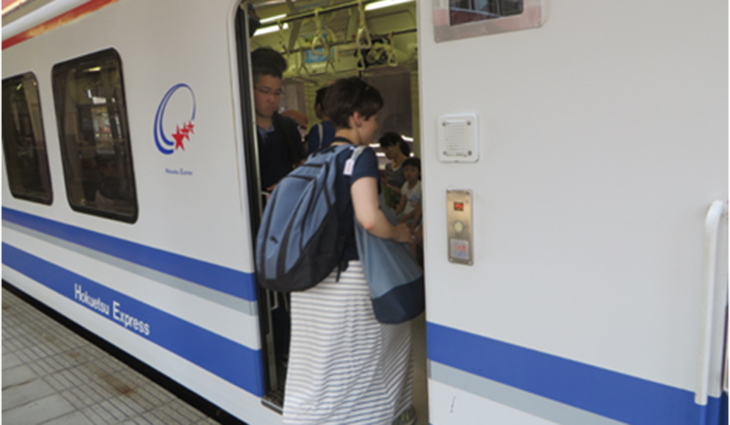 ① When boarding a train from a platform, note that boarding locations for each car number are indicated on the platform. Wait in line for your turn to board. Give priority to those getting off the train.
① When boarding a train from a platform, note that boarding locations for each car number are indicated on the platform. Wait in line for your turn to board. Give priority to those getting off the train.
 ② When getting off a car, quickly move away from the train. Train platforms are painted with white lines or have yellow "Braille blocks" for those with impaired vision. Stay behind these lines.
② When getting off a car, quickly move away from the train. Train platforms are painted with white lines or have yellow "Braille blocks" for those with impaired vision. Stay behind these lines.
3. Transfers
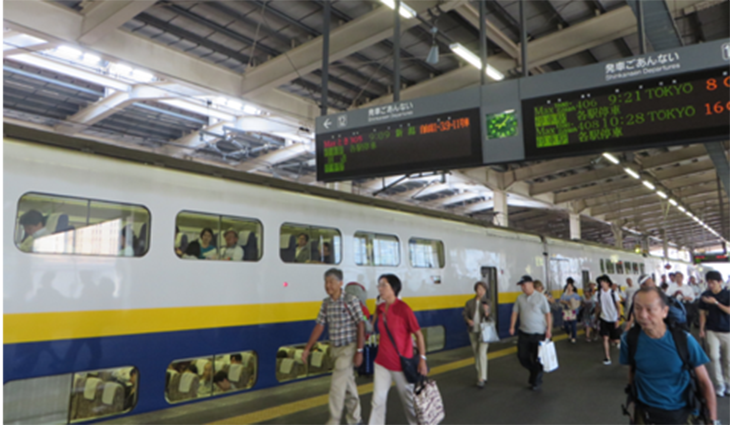 ① Here we use transfering from a shinkansen to a conventional line as an example. Transfers involve either exiting and then reentering a ticket gate, or passing through a transfer gate. If you are using a reduced-fare transfer ticket or connecting ticket, note that reduced fares may only be applied at transfer gates.
① Here we use transfering from a shinkansen to a conventional line as an example. Transfers involve either exiting and then reentering a ticket gate, or passing through a transfer gate. If you are using a reduced-fare transfer ticket or connecting ticket, note that reduced fares may only be applied at transfer gates.
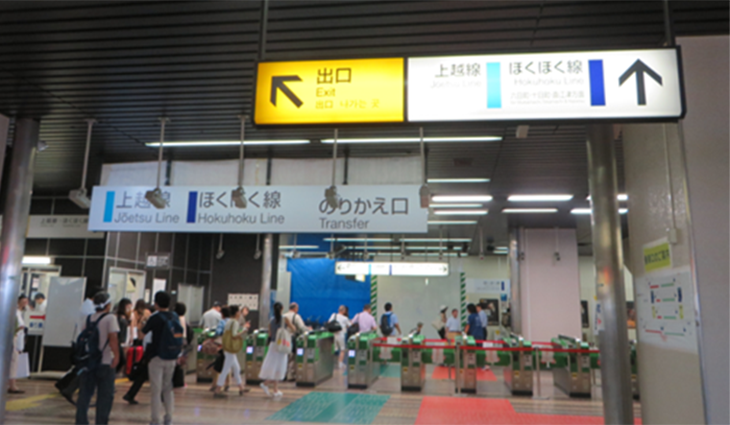 ② Exits (出口; deguchi) are where you can leave a station. Simply insert your ticket into the ticket gate or touch your IC card to the IC card sensor and pass through. With the exception of excursion, discount, or other special tickets, your ticket will not be returned to you upon exiting. Those using a JR Pass will need to proceed to a staffed ticket gate and present their pass.
② Exits (出口; deguchi) are where you can leave a station. Simply insert your ticket into the ticket gate or touch your IC card to the IC card sensor and pass through. With the exception of excursion, discount, or other special tickets, your ticket will not be returned to you upon exiting. Those using a JR Pass will need to proceed to a staffed ticket gate and present their pass.
If you wish to transfer, look for a sign that says Transfer Gate (のりかえ口; norikaeguchi). Pass through the transfer ticket gate and pick up your ticket. Remember to also collect any special tickets such as excursion tickets, connecting tickets, or discount tickets should you be using them. If using an IC card, simply touch the card to the IC card sensor. Those using a JR Pass will need to proceed to a staffed transfer gate and present their pass.
When unable to exit a ticket gate due to insufficient fare, use a nearby fare adjustment machine. Insert your ticket and pay the difference to receive an adjusted-fare ticket. If using an IC card, you will simply need to recharge your card with an amount that is at least equal to the amount due. If you cannot find a fare adjustment machine or do not know what to do, contact a station attendant.
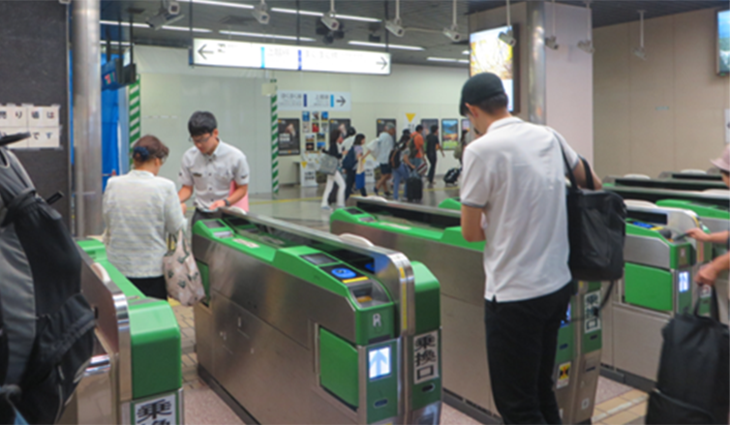 ③ Depending on the station, some transfers may not require you to pass through a transfer gate. In this case, simply follow signs to the departure track of your next train.
③ Depending on the station, some transfers may not require you to pass through a transfer gate. In this case, simply follow signs to the departure track of your next train.
 ④ Wait for the train to which you are transferring at its respective platform. The platform signboard will show destination and arrival information to help ensure that you board the correct train.
④ Wait for the train to which you are transferring at its respective platform. The platform signboard will show destination and arrival information to help ensure that you board the correct train.
Excursion Tickets
The following is a guide to convenient and affordable excursion tickets for sightseeing in Tokyo and Osaka.
Tokyo
 Tokyo Tour Ticket (Tokyo Furii Kippu)
Tokyo Tour Ticket (Tokyo Furii Kippu)
1-day pass that provides unlimited use of the JR lines and Tokyo Metro and Toei Subway lines running through central Tokyo
Price: ¥1,590
Where to buy: JR Green Window ticket counters, Tokyo Metro stations, Tokyo Metro automatic ticket machines, and Toei Subway stations
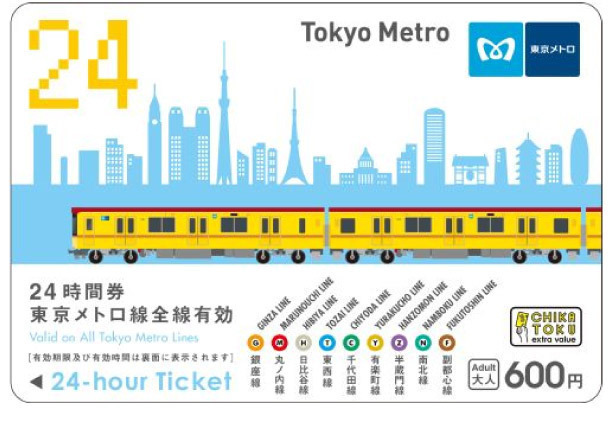 Tokyo Metro 24-hour Ticket
Tokyo Metro 24-hour Ticket
24-hour ticket that provides unlimited use of the Tokyo Metro
Price: ¥600
Where to buy: automatic ticket machines at Tokyo Metro stations
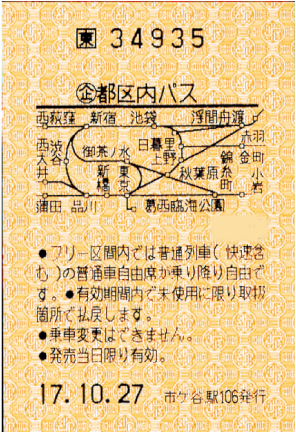 Tokyo Metropolitan District Pass (Tokunai Pass)
Tokyo Metropolitan District Pass (Tokunai Pass)
1-day pass that provides unlimited use of the JR local trains (including rapid trains) within Tokyo's 23 wards
Price: ¥750
Where to buy: JR Green Window ticket counters, View Plaza, etc. within Tokyo; separate tickets are required for faster trains (e.g. limited express tickets for limited express trains)
 Common One-day Ticket for Tokyo Metro & Toei Subway
Common One-day Ticket for Tokyo Metro & Toei Subway
1-day ticket for unlimited use for the Tokyo Metro and Toei Subway
Price: ¥1,000
Where to buy: automatic ticket machines at Tokyo Metro stations and Toei Subway stations
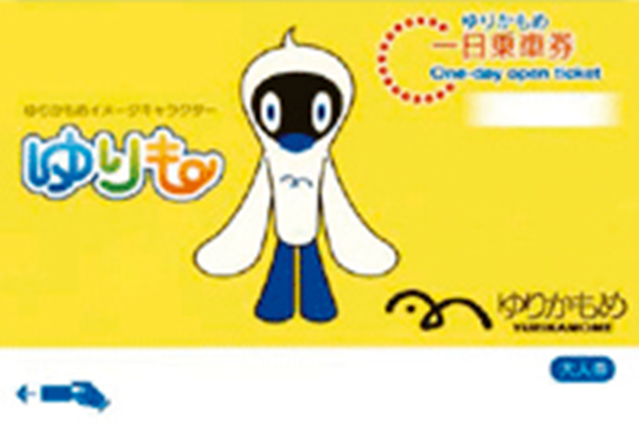 Yurikamome One-Day pass
Yurikamome One-Day pass
1-day pass for unlimited use of the Yurikamome line
Price: ¥820
Where to buy: Yurikamome line automatic ticket machines and ticket counters at Shimbashi and Toyosu stations
Osaka
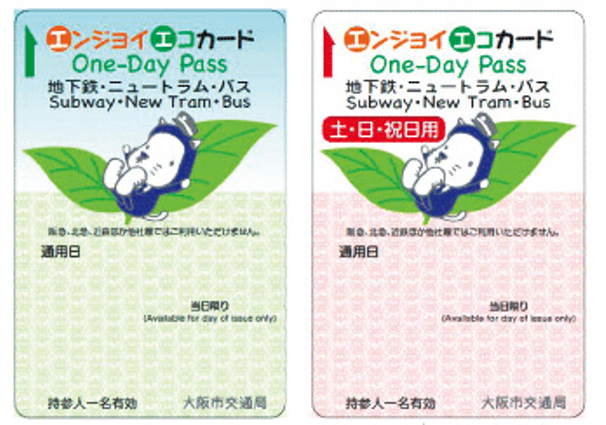 One-Day Ticket (Enjoy Eco Cards)
One-Day Ticket (Enjoy Eco Cards)
1-day ticket for unlimited use of all Osaka municipal subway, New Tram, and bus lines; can also be use at nearly 30 tourist facilities, etc. in Osaka city for discounts (*Applicable only while the ticket is valid)
Price: ¥800 (¥600 on weekends and holidays)
Where to buy: automatic ticket machines and ticket windows handling commuter passes
 Osaka Amazing Pass (1-day pass / 2-day pass)
Osaka Amazing Pass (1-day pass / 2-day pass)
Price: ¥2,300 (1-day pass) or ¥3,000 (2-day pass)
Where to buy: at all subway and New Tram Stations, tourist information centers, major hotels in Osaka City, private railway counters (1-day passes only), etc.
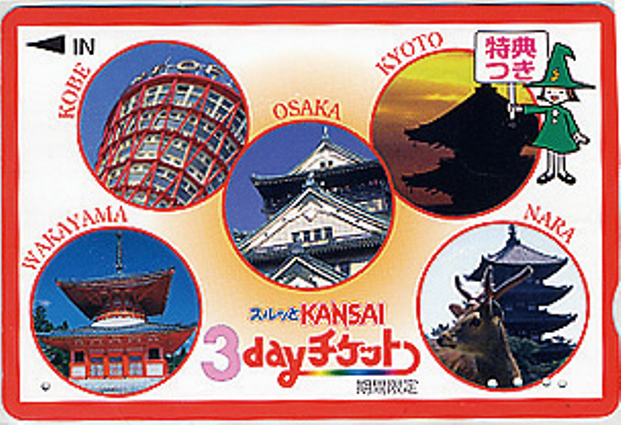 Kansai Thru Pass 3-day ticket
Kansai Thru Pass 3-day ticket
Passes for unlimited use of all major trains, subways, and buses in Kansai for any 3 days (need not be consecutive) during the period of validity; passholders can also receive rewards at some 350 amusement facilities, shrines, and temples throughout Kansai
Price: ¥5,200
Where to buy: major stations in Kansai
Shinkansen Trains
Shinkansen Trains
Shinkansen Lines
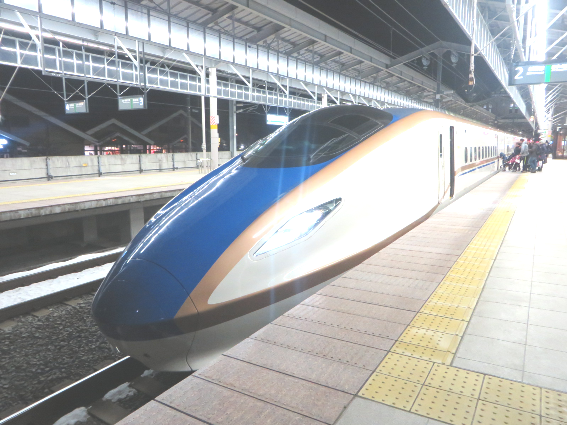
Operated by the JR Group, shinkansen trains are limited express trains that run on special shinkansen lines. The Akita Shinkansen (Akita <-> Tokyo) and Yamagata Shinkansen (Yamagata <-> Tokyo) lines split off from the Tohoku Shinkansen and run along the same route as conventional lines but are treated as shinkansen lines.
The shinkansen that run exclusively on shinkansen lines are as follows:
- Tohoku Shinkansen (Shin-Aomori <-> Tokyo)
- Joetsu Shinkansen (Niigata <-> Tokyo)
- Hokuriku Shinkansen (Kanazawa <-> Nagano <-> Tokyo)
- Tokaido Shinkansen (Tokyo <-> Shin-Osaka)
- Sanyo Shinkansen (Shin-Osaka <-> Hakata)
- Kyushu Shinkansen (Hakata <-> Kagoshima-chuo)
- Hokkaido Shinkansen* (Shin-Hakodate Hokuto <-> Shin-Aomori)
*Scheduled to open March 2016
Shinkansen Train Types and Fares
Some shinkansen trains stop only at major stations while some stop at all stations. Each type has its own name. Some examples are the Nozomi trains, which are the fastest on the Tokaido line, the Hikari, which stop at all Nozomi stations as well as several more, and the Kodama, which stop at all stations. As they are all priced differently and have different passenger volumes, you will need to choose based on your destination and schedule. Also, be aware that Japan Rail Passes cannot be used for the Nozomi (Tokaido Shinkansen) or Mizuho (Kyushu Shinkansen) lines.
Regarding reserved seating, some trains have reserved seating only while others offer non-reserved seating as well. For all-reserved trains, standing limited express tickets are sold only when all seats are taken, with passengers allowed to stand in the vestibules. Boarding is otherwise only permitted if you have purchased a reserved ticket and been assigned a seat. Non-reserved seating also requires a non-reserved limited express ticket.
Shinkansen Line Map
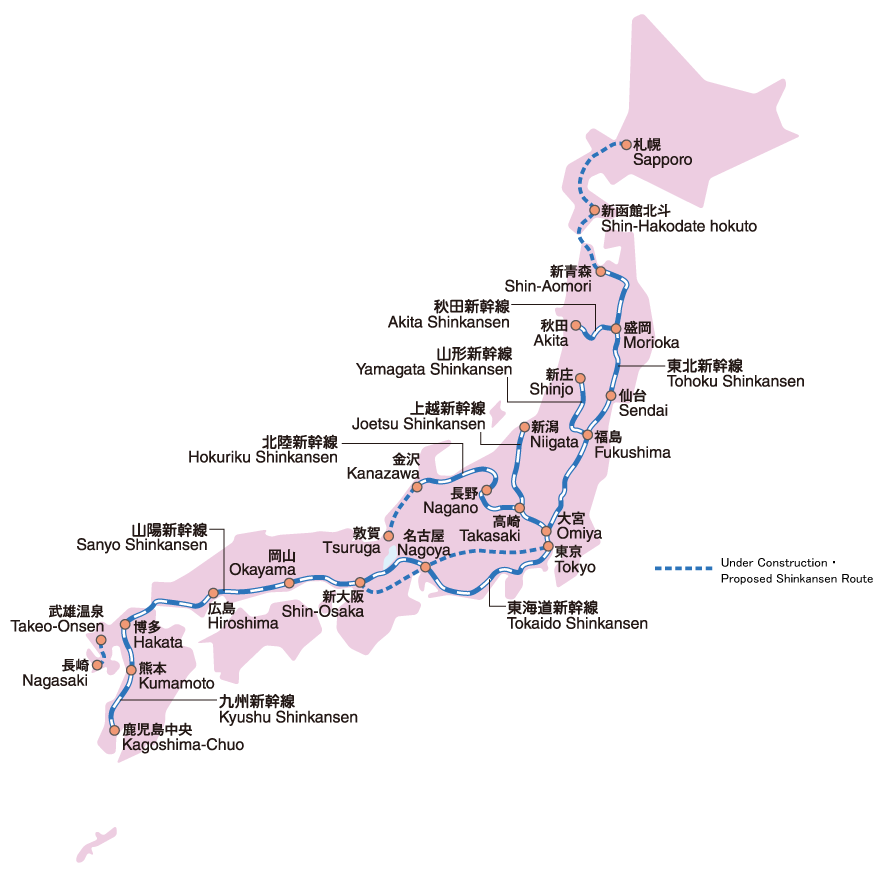
Purchasing Tickets
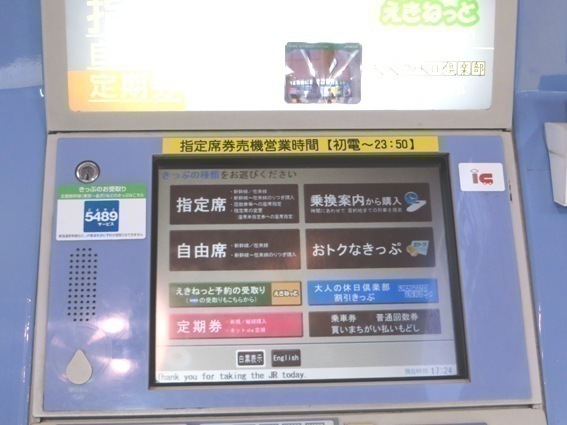 ① Press the English button on the ticket machine.
① Press the English button on the ticket machine.
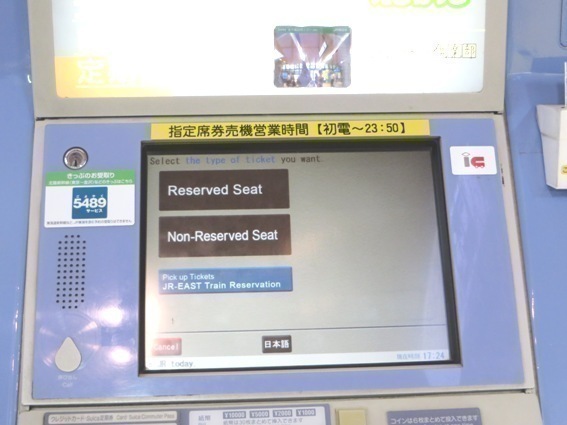 ② Choose either reserved seat or non-reserved seat. If you have already reserved a ticket, press the ticket pickup button.
② Choose either reserved seat or non-reserved seat. If you have already reserved a ticket, press the ticket pickup button.
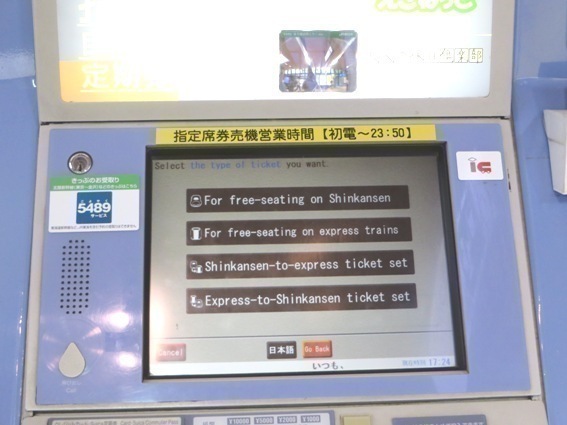 ③ Choose whether you want only a shinkansen ticket, a super (limited) express ticket, or both.
③ Choose whether you want only a shinkansen ticket, a super (limited) express ticket, or both.
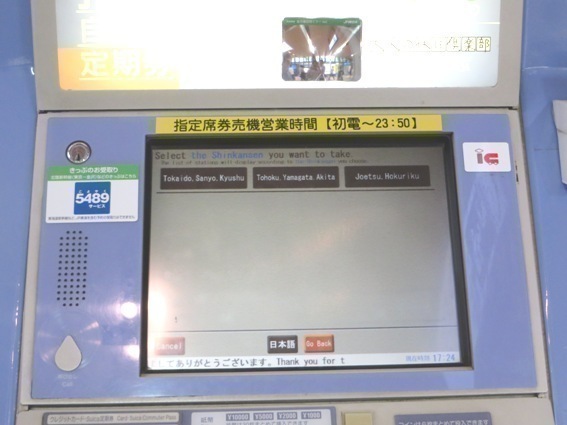 ④ Choose the shinkansen line you wish to take.
④ Choose the shinkansen line you wish to take.
 ⑤ Choose a starting station. Your starting station can either be the station from which you board the shinkansen, or the station you will use to get to the nearest station with a shinkansen connection.
⑤ Choose a starting station. Your starting station can either be the station from which you board the shinkansen, or the station you will use to get to the nearest station with a shinkansen connection.
 ⑥ If your starting station is not one with a shinkansen connection, you will be asked at which station you will board the shinkansen.
⑥ If your starting station is not one with a shinkansen connection, you will be asked at which station you will board the shinkansen.
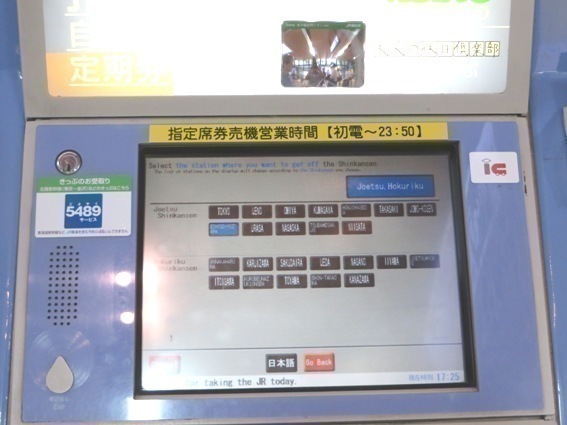 ⑦ Choose an ending station for the shinkansen. This may be different from your final station.
⑦ Choose an ending station for the shinkansen. This may be different from your final station.
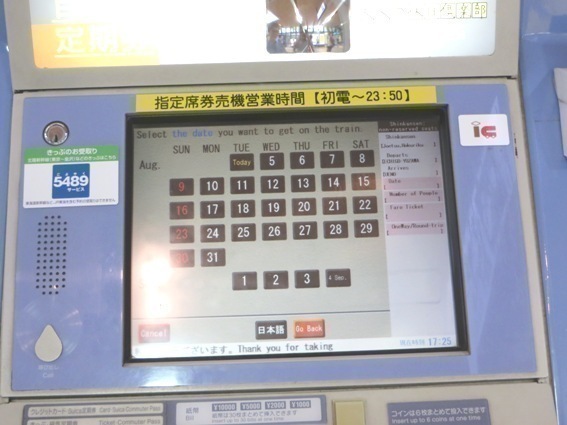 ⑧ Choose your departure date. Tickets can be purchased up to one month in advance.
⑧ Choose your departure date. Tickets can be purchased up to one month in advance.
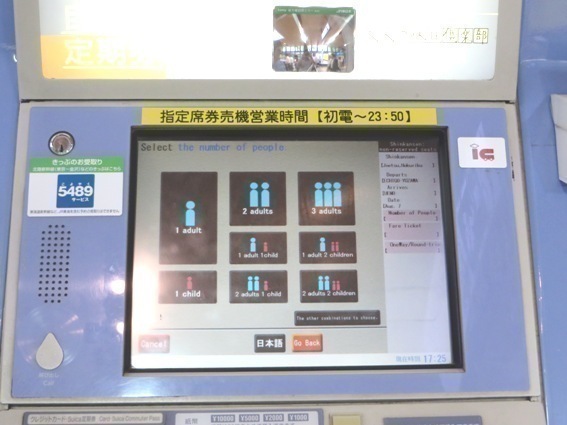 ⑨ Choose the number of adult and children passengers.
⑨ Choose the number of adult and children passengers.
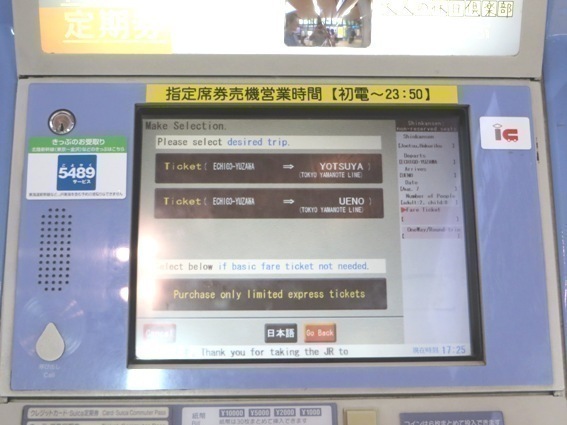 ⑩ Choose whether to buy a ticket (base fare ticket) together with a super (limited) express ticket or only a limited express ticket.
⑩ Choose whether to buy a ticket (base fare ticket) together with a super (limited) express ticket or only a limited express ticket.
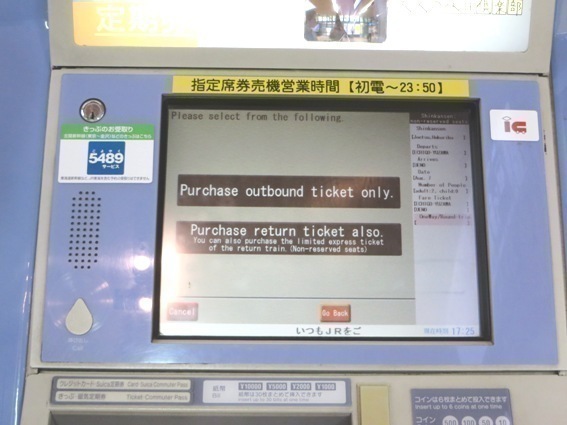 ⑪ Choose whether to buy a one-way ticket or a round-trip ticket.
⑪ Choose whether to buy a one-way ticket or a round-trip ticket.
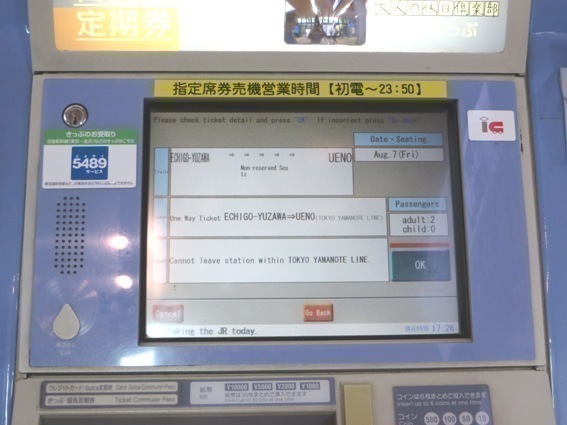 ⑫ Confirm your purchase choices. To make changes, press the Back button or press the OK button to proceed.
⑫ Confirm your purchase choices. To make changes, press the Back button or press the OK button to proceed.
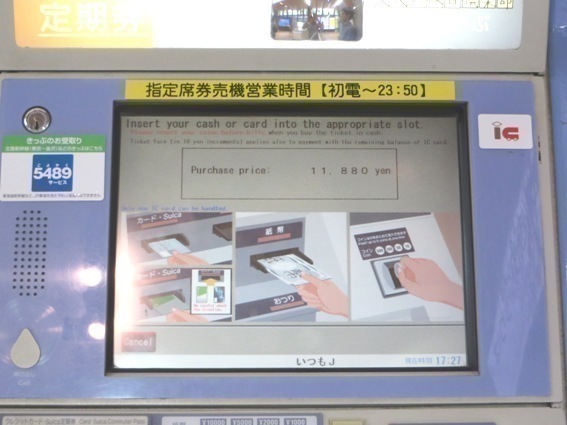 ⑬ This screen shows your payment options. Payment may be made using a credit card (check with a station attendant to make sure the card is accepted), an IC card, cash, or coins.
⑬ This screen shows your payment options. Payment may be made using a credit card (check with a station attendant to make sure the card is accepted), an IC card, cash, or coins.
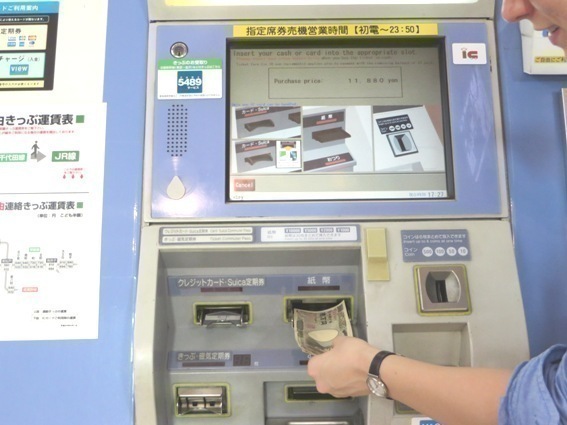 ⑭ Different insertion slots are used for different payment methods. Use the insertion slot for your method of payment.
⑭ Different insertion slots are used for different payment methods. Use the insertion slot for your method of payment.
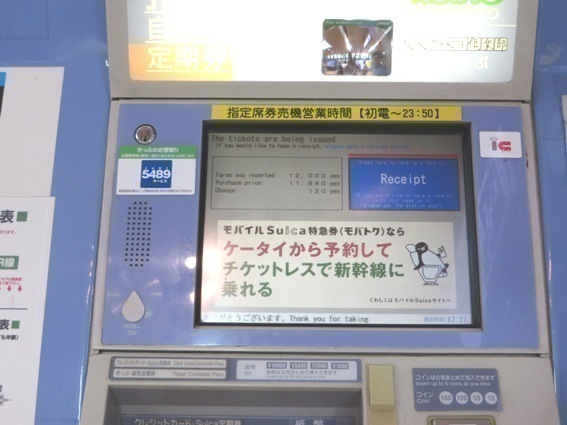 ⑮ If you need a receipt, press the Receipt button. If using a credit card, you will receive a transaction statement.
⑮ If you need a receipt, press the Receipt button. If using a credit card, you will receive a transaction statement.
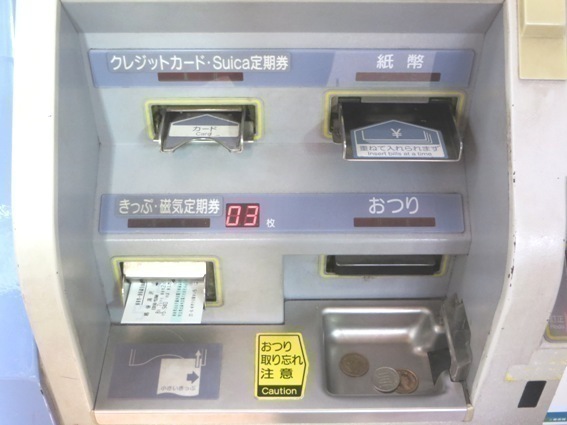 ⑯ Don't forget to take your ticket, change, and receipt!
⑯ Don't forget to take your ticket, change, and receipt!
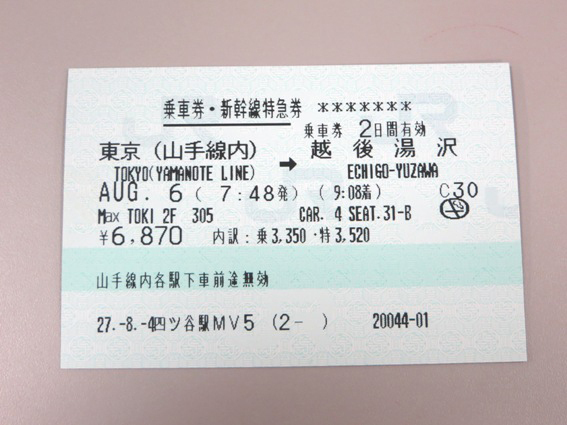 ⑰ This is a sample ticket. This ticket is a combination base fare ticket and shinkansen super (limited) express ticket. Note that base fare tickets and super (limited) express tickets are issued separately depending on how they are purchased.
⑰ This is a sample ticket. This ticket is a combination base fare ticket and shinkansen super (limited) express ticket. Note that base fare tickets and super (limited) express tickets are issued separately depending on how they are purchased.
Features On-Board the Shinkansen
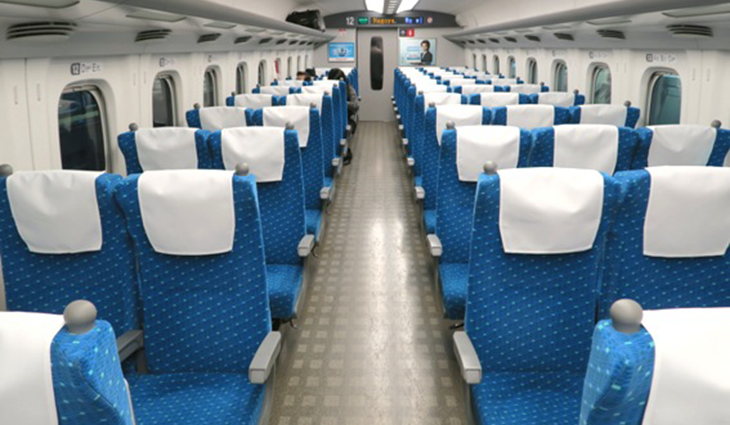 In most JR shinkansen and limited express cars, seat rows are numbered and seats are designated with A, B, C, etc., with A being the window seat. Every car has somewhere between 10 and 20 rows.
In most JR shinkansen and limited express cars, seat rows are numbered and seats are designated with A, B, C, etc., with A being the window seat. Every car has somewhere between 10 and 20 rows.
 There are five seats to every row in reserved-seat and non-reserved seat cars on shinkansen trains. A is the window seat, followed by seats B and C, and then D and E are across the aisle. Row numbers have no relation to the direction of travel, and row 1 could be the back row.
There are five seats to every row in reserved-seat and non-reserved seat cars on shinkansen trains. A is the window seat, followed by seats B and C, and then D and E are across the aisle. Row numbers have no relation to the direction of travel, and row 1 could be the back row.
Green cars have four seats to a row and are designated by A, B, C, and D (with AB CD grouping). Seat layouts are different again for Gran Class and other special cars.
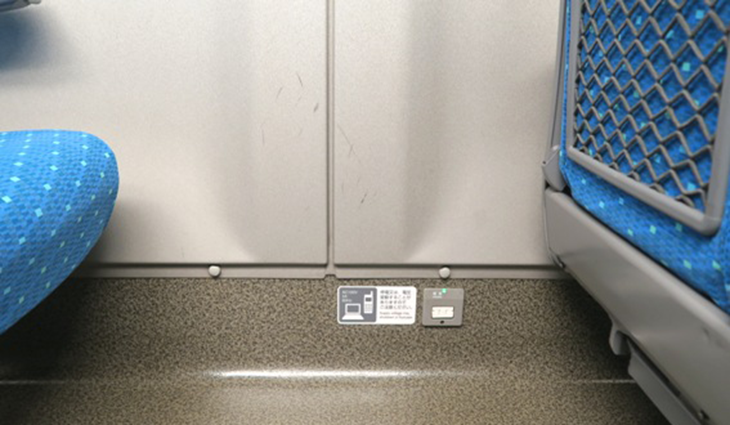 Almost all shinkansen seats have power outlets. Outlet configurations differ with the type of shinkansen: some cars have outlets on all seats, some have outlets only on window seats, etc.
Almost all shinkansen seats have power outlets. Outlet configurations differ with the type of shinkansen: some cars have outlets on all seats, some have outlets only on window seats, etc.
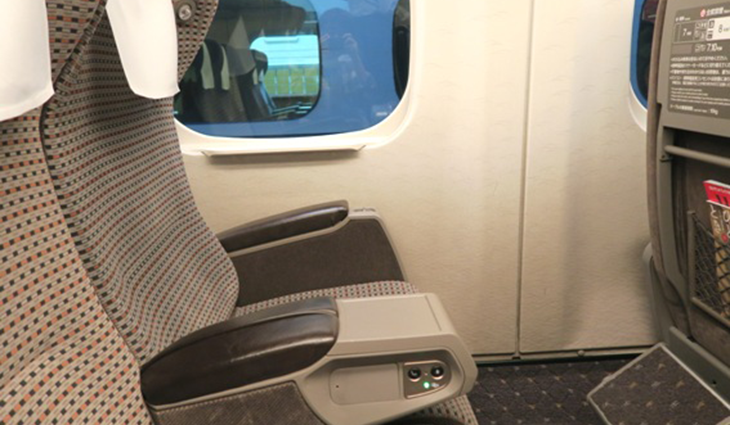 Every seat back can be reclined in shinkansen cars. In green cars, foot rests can be moved. Gran Class cars use an electric reclining system.
Every seat back can be reclined in shinkansen cars. In green cars, foot rests can be moved. Gran Class cars use an electric reclining system.
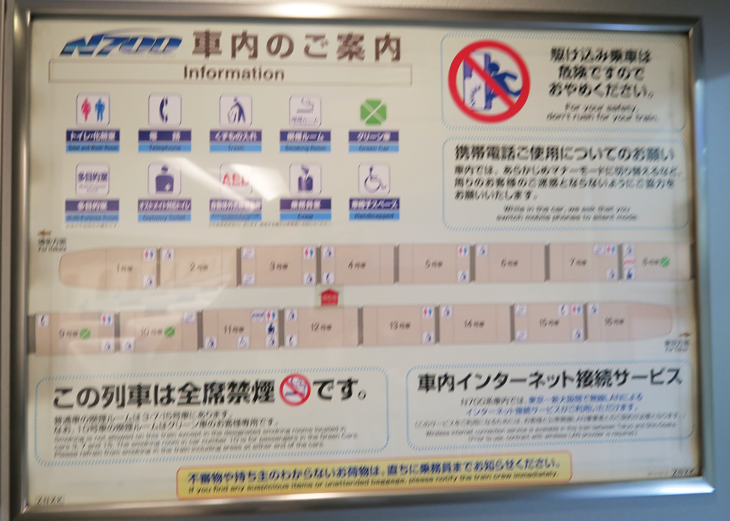 Every shinkansen car features a restroom, a wheelchair accessible restroom, sink, telephone, AED, trashcan, nursing area, changing table, and crew cab. Food and drink are sold by vendors on most trains except those such as the Tokaido Shinkansen's Kodama trains.
Every shinkansen car features a restroom, a wheelchair accessible restroom, sink, telephone, AED, trashcan, nursing area, changing table, and crew cab. Food and drink are sold by vendors on most trains except those such as the Tokaido Shinkansen's Kodama trains.
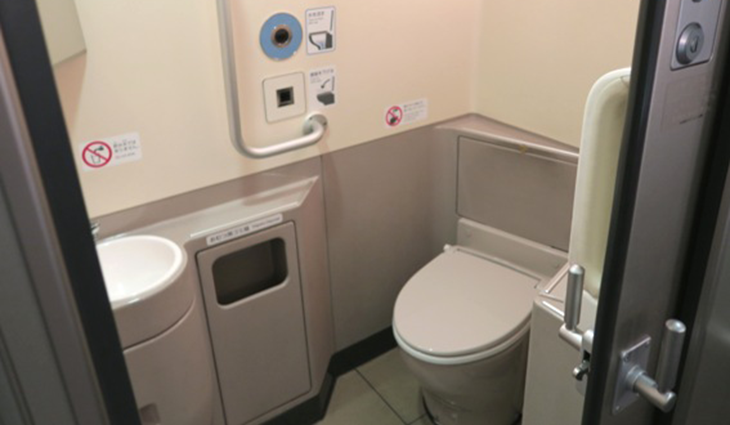 Restrooms are located in the odd numbered cars of the Shinkansen. Depending on the type of Shinkansen, there may be separate restrooms for men and women. Some of the cars may have a Japanese-style toilet in the restroom, but all newer cars are equiped with Western-style toilets. Wheelchair accesible restrooms are available, as are those with automatic doors.
Restrooms are located in the odd numbered cars of the Shinkansen. Depending on the type of Shinkansen, there may be separate restrooms for men and women. Some of the cars may have a Japanese-style toilet in the restroom, but all newer cars are equiped with Western-style toilets. Wheelchair accesible restrooms are available, as are those with automatic doors.
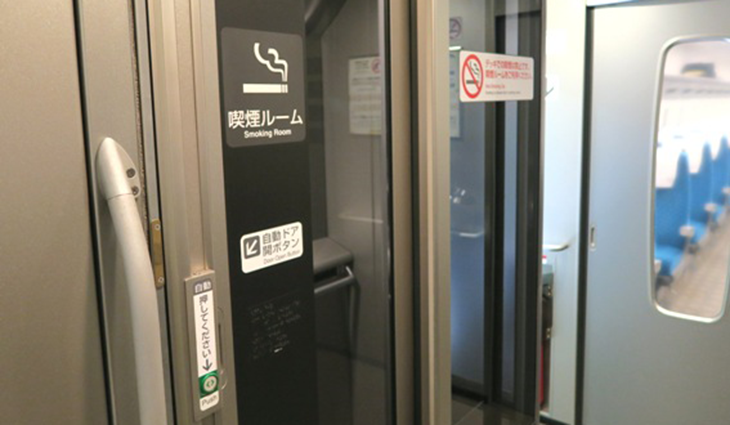
All shinkansen cars generally prohibit smoking but have a designated smoking room.
Japan Rail Pass
Japan Rail Pass
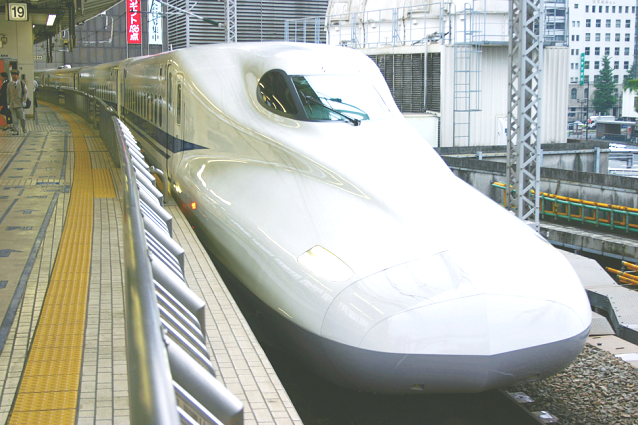
Japan Rail Passes (also known as the JR Pass) are jointly provided by the six JR Group companies. They are bargain-priced passes that allow passengers to travel all over Japan by train. As they allow passengers to ride shinkansen trains and get a better deal than buying tickets individually, they are a necessity when traveling long distance.
Who Can Buy a JR Pass
(1) Foreign travelers coming from a foreign country to visit Japan on short stays for tourism purposes
(2) People of Japanese nationality who live in a foreign country and meet the conditions below:
a. They have permanent resident status in the foreign country
b. They are married to a non-Japanese living outside of Japan.
Pass Types and Fares
Adult passes for green cars:
7-day pass ¥38,880
14-day pass ¥62,950
21-day pass ¥81,870
Adult passes for regular cars:
7-day pass ¥29,110
14-day pass ¥46,390
21-day pass ¥59,350
Scope of JR Pass Service
- All JR Group shinkansen lines (excluding Nozomi and Mizuho lines (which both include non-reserved seating), limited express trains, express trains, rapid trains, local trains, and BRT (with some exceptions.) )
- Tokyo Monorail
- Aoimori Railway (Aomori to Hachinohe) (*local and rapid trains; passholders' travel must encompass the segments between Hachinohe and Aomori, Aomori and Noheji, and Hachinohe and Noheji. Passholders may only disembark at Aomori, Noheji, and Hachinohe stations on the Aoimori Line)
- IR Ishikawa Railway (Kanazawa to Tsubata) (*local and limited express trains; passholders may only travel between these two stations. With the exception of Kanazawa and Tsubata, passholders may not disembark at other stations on the IR Ishikawa line in this segment)
- Ainokaze Toyama Railway (Toyama to Takaoka) (*local trains; passholders may only travel between these two stations. With the exception of Toyama and Takaoka, passholders may not get off at other stations on the Ainokaze Toyama line)
- When traveling on private rail companies' lines that have through service to JR lines, additional fares and fees may apply
- Local lines operated by JR Bus companies (excludes certain local lines. Lines available to passholders are subject to change.)
- JR bus companies: JR Hokkaido, JR Bus Tohoku, JR Bus Kanto, JR Tokai Bus, West Japan JR Bus, Chugoku JR Bus, JR Shikoku Bus, and JR Kyushu Bus
Using a Japan Rail Pass
- A JR Pass may only be used by the person(s) whose name(s) appear on the pass.
- Always present your pass to the station attendant at the ticket gate and receive a stamp confirming your pass was checked.
- Carry your passport with you when traveling and show it to staff when asked.
Purchasing Japan Rail Passes
As Japan Rail Passes cannot be purchased within Japan, purchase an Exchange Order at the below affiliated offices before coming to Japan.
- JTB Corp.
- Nippon Travel Agency
- KINTETSU INTERNATIONAL
- Tobu Top Tours
- Japan Airlines*
- All Nippon Airways*
- JALPAK and their respective agencies.
Exchanging Vouchers for Japan Rail Passes

When you arrive in Japan, you will need to have the Exchange Order you purchased converted into a Japan Rail Pass.
To receive your Japan Rail Pass, present your Exchange Order at an exchange office at any major JR station along with the certificate verifying your purchase. Here is a list of major exchange locations
Riding the Shinkansen with a Japan Rail Pass
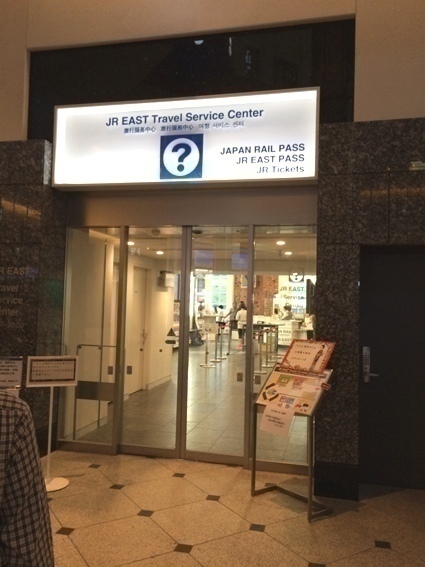
You can use your Japan Rail Pass for both reserved or non-reserved seats on the shinkansen.
To reserve a seat on a shinkansen, present your Japan Rail Pass at a travel center at a JR station, at the Green Window ticket counter, or at a travel agency designated by JR. No surcharge is applied when reserving a seat.
For non-reserved seats, you only need to present your Japan Rail Pass when entering the ticket gate. Please note that you may not be able to find a seat when traveling during peak seasons.
Notes
- Extra charges will apply for Nozomi or Mizuho shinkansen train passengers and for those who reserve a private room, sleeper, green car (unless the pass holder has a green car ticket), or Gran Class car.
- There are some unmanned stations and other stations where reserved seat tickets cannot be issued.
THIS ARTICLE IS BASED ON INFORMATION FROM 09 21,2016








